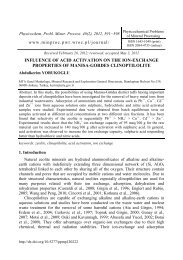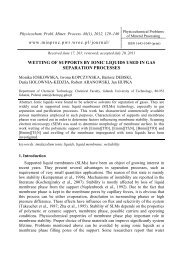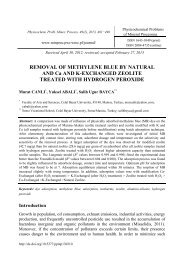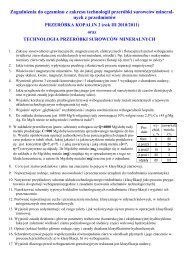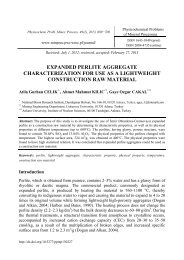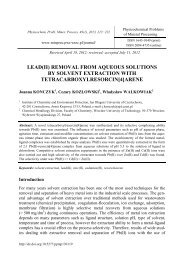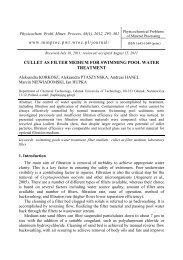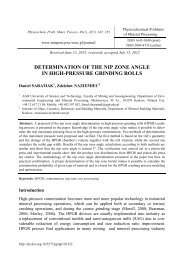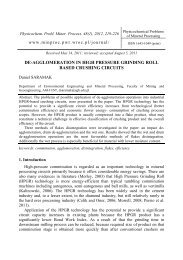Contaminants of post-leaching copper solutions and their behavior ...
Contaminants of post-leaching copper solutions and their behavior ...
Contaminants of post-leaching copper solutions and their behavior ...
You also want an ePaper? Increase the reach of your titles
YUMPU automatically turns print PDFs into web optimized ePapers that Google loves.
Physicochem. Probl. Miner. Process. 49(1), 2013, 133−143www.minproc.pwr.wroc.pl/journal/Physicochemical Problems<strong>of</strong> Mineral ProcessingISSN 1643-1049 (print)ISSN 2084-4735 (online)Received March 16, 2012; reviewed; accepted July 9, 2012CONTAMINANTS OF POST-LEACHING COPPERSOLUTIONS AND THEIR BEHAVIOR DURINGEXTRACTION WITH INDUSTRIAL EXTRACTANTSLeszek GOTFRYD, Grzegorz PIETEKInstitute <strong>of</strong> Non-Ferrous Metals, Sowińskiego 5; 44-100 Gliwice, Pol<strong>and</strong>, leszekg@imn.gliwice.plAbstract: Several <strong>copper</strong> extractants have been examined in laboratory glassware with a special attentionpaid to <strong>their</strong> <strong>behavior</strong> towards cations others than <strong>copper</strong>(II). In the studies 25 vol. percent <strong>of</strong> hydrocarbon(Exxsol D80 AZ) <strong>solutions</strong> <strong>of</strong> six industrial <strong>copper</strong> extractants have been used. They were mainly reagents<strong>of</strong> hydrooxime type (LIX 860N-IC, LIX 984, LIX 984N, LIX 84-I, Acorga M5640) <strong>and</strong> diketonetype LIX 54-100. Individual isotherms <strong>of</strong> independent extraction <strong>of</strong> <strong>copper</strong>(II) <strong>and</strong> selected cations (Fe 3+ ,Fe 2+ , Co 2+ , Ni 2+ , Zn 2+ , Mn 2+ , Cd 2+ , Mg 2+ ) versus equilibrium pH have been compared. Investigations havebeen conducted with synthetic 0.1 mol/L <strong>solutions</strong> <strong>of</strong> <strong>their</strong> sulfates. The values <strong>of</strong> pH 50% − parameterdefined as an equilibrium pH at the moment <strong>of</strong> half-<strong>and</strong>-half extraction <strong>of</strong> the investigated cationic specieshave been presented. Also ΔpH 50% , that is differences between values <strong>of</strong> pH 50% for specific cationMe(II) <strong>and</strong> <strong>copper</strong>(II): ΔpH 50% = pH 50% (Me) − pH 50% (Cu), have been given. In addition to that 25% LIX984 has been used in counter-current pilot trials for <strong>copper</strong>(II) extraction from naturally contaminated<strong>solutions</strong> produced by bio<strong>leaching</strong> <strong>of</strong> industrial sulfide <strong>copper</strong> concentrate to observe <strong>behavior</strong> <strong>of</strong> investigatedcontaminants such as correlations between <strong>their</strong> real co-extraction with <strong>copper</strong>(II) <strong>and</strong> the position<strong>of</strong> <strong>their</strong> extraction on the pH scale. Copper electrolyte/strip solution, working alternately within close loop<strong>of</strong> coupled stripping - electrowinning system, has been analyzed during consecutive cycles to observebuilding up <strong>of</strong> the contaminants concentrations in the course <strong>of</strong> test.Keywords: industrial <strong>copper</strong> extractants, <strong>copper</strong> contaminants, <strong>copper</strong> extraction isothermsIntroductionDominant amounts <strong>of</strong> worldwide <strong>copper</strong> production come from <strong>copper</strong> ores which,after mining, crushing, grinding <strong>and</strong> enrichment by flotation to 20-30 % Cu, are processedpyrometallurgically into metallic <strong>copper</strong>. Also most <strong>of</strong> <strong>copper</strong> scrap is recoveredby melting <strong>and</strong> pyrometallurgical refining. Crude blister <strong>copper</strong> is finally refinedusing hydrometallurgical electrolytic means to produce <strong>copper</strong> cathodes. A simpler,fully hydrometallurgical method to obtain electrolytic <strong>copper</strong> is based on the ion exchangesolvent extraction technique. About 20% <strong>of</strong> the world <strong>copper</strong> production ishttp://dx.doi.org/10.5277/ppmp130113
134 L. Gotfryd, G. Pietekprocessed this way. Mostly poor <strong>and</strong> oxidized raw materials, unsuitable for flotation,are processed by means <strong>of</strong> extraction even though quite effective methods <strong>of</strong> bio<strong>leaching</strong>are available, which guarantee dissolution <strong>of</strong> rich sulfide <strong>copper</strong> concentrates bybio<strong>leaching</strong> (bacterial <strong>and</strong>/or fungal) <strong>and</strong> transforming them into <strong>copper</strong>(II) sulfate(VI)<strong>solutions</strong> <strong>and</strong> elemental sulfur. Generally, hydrometallurgical technology <strong>of</strong> <strong>copper</strong>production consists <strong>of</strong> raw material <strong>leaching</strong> (<strong>of</strong>ten using heaps or piles) with sulfuricacid <strong>solutions</strong> in the form <strong>of</strong> <strong>post</strong>-extraction raffinate or depleted <strong>copper</strong> electrolyte,solid/liquid separation (sedimentation <strong>and</strong> filtration) <strong>and</strong> final extractive treatment <strong>of</strong>the solution. The extracted <strong>copper</strong> is recovered as a stripped liquor being a moderatelyacidic <strong>copper</strong> sulfate solution <strong>and</strong> containing, for example, 55 g/dm 3 Cu(II) <strong>and</strong> 130g/dm 3 H 2 SO 4 ). Next, it is subjected to electrolysis to obtain <strong>copper</strong> cathodes as thefinal product, with a simultaneous acid regeneration in amounts equimolar to deposited<strong>copper</strong> (e.g. 30 g/dm 3 Cu(II) <strong>and</strong> 179 g/dm 3 H 2 SO 4 ). Regenerated electrolyte isused again in cycles as a stripping factor.Reagents for <strong>copper</strong> extractionCurrently there are two basic types <strong>of</strong> reagents capable to extract <strong>copper</strong>(II) from concentrated<strong>and</strong>/or acidic <strong>solutions</strong> which show high selectivity towards iron(III). Theyare <strong>of</strong> (hydroxy)oxime character – derivatives <strong>of</strong> aromatic ketones or aldehydes withelongated linear alkyl substituent attached – i.e. alkylaromatic ketoximes or aldoximes.Commercially available are 2-hydroxy-5-nonylacet<strong>of</strong>enoxime /LIX 84-I/, 5-dodecylsalicylaldoxime/LIX 860/ <strong>and</strong> 5-nonylsalicylaldoxime /LIX 860N or AcorgaP-50/ (MTC Redbook, 2011, Cytec Industries technical brochures, 2011, Kordosky etal., 1983, 2003; Merigold, 1996, Agers, 1972). They contain basic ingredients whichare used to compose extractants applied in industry by blending them with organicsolvents (hydrocarbon) as well as with some supplementary additives (modifiers), e.g.phenoles (p-nonylphenol), higher alcohols (tridecanol), esters <strong>and</strong> similar. Those extracomponents have some influence on extraction characteristics (mitigating, decreasingextraction power causing s<strong>of</strong>tening <strong>of</strong> the stripping conditions), as well as on physical<strong>and</strong> chemical properties such as diminishing viscosity <strong>and</strong> increasing surface tension(Merigold, 1996).Presently there are three companies manufacturing industrial amounts <strong>of</strong> reagents<strong>of</strong> the discussed types. Cognis Corporation (MTC Redbook, 2011) mainly producesLIX 84-I <strong>and</strong> LIX 860N-I, whereas Cytec Industries Inc. (Cytec Industries technicalbrochures, 2011) supplies a reagent called (Acorga) P50 while AllCo Chemicals providesaldoxime type reagent MOC 45. Due to these reagents numerous commercialproducts are available including LIX 984, 984N, 973N (blends <strong>of</strong> LIX 84-I <strong>and</strong> LIX860), LIX 622N <strong>and</strong> 664N (LIX 860 with tridecanol or ester added); Acorga M 5640,PT 5050, P5100 (modified P-50); MOC 55TD. Evaluation <strong>of</strong> both types <strong>of</strong> extractantsshows an advantage <strong>of</strong> the ketoxime type reagents. They are more resistant to hydrolysisunder stripping conditions at elevated temperature than aldoximes. One <strong>of</strong> the rea-
<strong>Contaminants</strong> <strong>of</strong> <strong>post</strong>-<strong>leaching</strong> <strong>copper</strong> <strong>solutions</strong> <strong>and</strong> <strong>their</strong> <strong>behavior</strong> during extraction… 135sons is that they do not need to be blended with modifiers. They can be stripped witha typical <strong>copper</strong> electrolyte (Kordosky, 2003; Merigold, 1996).To extract <strong>copper</strong> other chemical compounds can be used, e.g. β-diketones, havingstructure <strong>of</strong> R 1 COCH 2 COR 2 , where R 1 = -(CH 2 ) 6 CH 3 , R 2 = -C 6 H 4 -R <strong>and</strong> R is an alkylsubstituent /LIX 54-100 = 1-phenyldecane-1,3-dion/. Their power <strong>of</strong> <strong>copper</strong> extractionis slightly lower. Additionally, they are not selective against iron(III), which presentsan important disadvantage, limiting in practice <strong>their</strong> application to cuprammonium<strong>solutions</strong> (Kordosky, 2003; Agers, 1972; Jenkins et al., 1999).Copper(II) can be extracted with many other reagents, including organic derivatives<strong>of</strong> acidic compounds <strong>of</strong> phosphorus /DEHPA = bis(2-ethylhexyl)phosphoricacid, PC88A = (2-ethylhexyl)2-ethylhexylphosphoric acid, Cyanex 272 = bis(2,4,4-trimetypentyl)phosphinic acid/, carboxylic /naphtenic, versatic/ <strong>and</strong> sulphonic acids,<strong>and</strong> hydroxyquinolines. Quite <strong>of</strong>ten they present disadvantage <strong>of</strong> poor selectivityagainst many cations <strong>and</strong>/or very strong co-extraction <strong>of</strong> Fe(III), which in practiceleads to a permanent poisoning <strong>of</strong> the extractant.<strong>Contaminants</strong> <strong>of</strong> the <strong>post</strong>-<strong>leaching</strong> solution <strong>and</strong> selectivity<strong>of</strong> <strong>copper</strong> extractionLeaching <strong>of</strong> <strong>copper</strong>-bearing materials with sulfuric acid <strong>solutions</strong> is not selective. Togetherwith the main ingredient also its contaminants (Fe, Zn, Mg, Ni, Co, As) permeateto the <strong>solutions</strong>. Copper(II) extraction from such <strong>solutions</strong>, however, leads to production<strong>of</strong> relatively pure <strong>copper</strong>(II) sulfate(VI) <strong>solutions</strong>, which can be seen asa definite advantage <strong>of</strong> those extractants used for <strong>copper</strong> recovery. Requirements withrespect to the contents <strong>of</strong> contaminants in <strong>copper</strong> electrolyte are not especially high (incomparison, for instance to zinc or manganese sulfate <strong>solutions</strong> prepared for electrolysis).Therefore, no special attention is paid to <strong>their</strong> level when they are present withinrelatively broad <strong>and</strong> acceptable limits. It is especially related to such ingredients asnickel, cobalt, arsenic, antimony, <strong>and</strong> to some lower degree also to iron. Some <strong>of</strong> them(Co) might be even desirable in the electrolyte, to prevent corrosion <strong>of</strong> insoluble leadanodes by causing <strong>their</strong> advantageous polarization. These facts, to a considerable degree,justify why there is scarcity <strong>of</strong> information in technical literature concerninglevels <strong>of</strong> contaminants transferred to the electrolyte, except for iron, which is typicallyused to determine selectivity <strong>of</strong> <strong>copper</strong> extraction. It is suggested that selectivity <strong>of</strong><strong>copper</strong> over iron defined as Cu/Fe in the stripped <strong>solutions</strong> (<strong>copper</strong> electrolytes) isfrom 2000 to ≥ 2500 (MTC Redbook, 2011; Cytec Industries technical brochures,2011).This study represents both an attempt to verify those data on iron(III) cation <strong>and</strong> alsoan effort to fill up the gap in information on the <strong>behavior</strong> <strong>of</strong> other elements. Therefore,it represents also an attempt to show potential differences between extractants,present on the market <strong>and</strong> in industry, considering <strong>their</strong> <strong>copper</strong>(II) extraction selectivityagainst iron(III) as well as against other ingredients <strong>of</strong> treated <strong>solutions</strong>.
136 L. Gotfryd, G. PietekHow to compare particular extractants? Methodology <strong>of</strong> the researchIn this respect the indicative quantitative information is defined by pH <strong>of</strong> half extraction<strong>of</strong> the examined cation denoted as pH 50% , indicating pH at which, at thermodynamicequilibrium, half <strong>of</strong> the amount <strong>of</strong> the cation in the feed solution subjected toextraction was extracted to the organic phase <strong>of</strong> the extractant. The value <strong>of</strong> pH 50%depends on extractant concentration in the organic phase <strong>and</strong> cation concentration inthe aqueous one. It depends on a volumetric ratio <strong>of</strong> reacting phases, temperature, <strong>and</strong>other factors. Generally, under established conditions, this parameter characterizes thepair <strong>of</strong> extractant <strong>and</strong> cation. Relative position on the pH scale <strong>of</strong> graphs presentingpercent <strong>of</strong> extraction vs. equilibrium pH curves, <strong>and</strong> the pH 50% values in particular, forvarious extracted cations, that is an order <strong>of</strong> <strong>their</strong> extraction, is a characteristic feature<strong>of</strong> a particular extractant. It describes its <strong>behavior</strong> versus the ingredients <strong>of</strong> treatedsolution. The range <strong>and</strong> the slope <strong>of</strong> the essential part <strong>of</strong> the particular curve is also <strong>of</strong>some importance.To create extractant/cation characteristics for comparison, very diluted salt <strong>solutions</strong><strong>of</strong> investigated cations Me 2+ (0.001–0.01 mol/dm 3 ) <strong>and</strong> from 2.5 to 3.0-fold concentratedorganic <strong>solutions</strong> <strong>of</strong> extractants are tested. For more practical applicationsthe extractants are prepared in a form <strong>and</strong> concentration used by industry <strong>and</strong> the cationsin a form <strong>of</strong> <strong>their</strong> independent <strong>and</strong> still comparatively diluted (0.05-0.1 mol/dm 3 )salt <strong>solutions</strong>. The second method has been applied in the presented study.ExperimentalExtractants <strong>and</strong> chemicalsThe following solvent extraction reagents were used (main ingredients in parenthesis):• LIX 860N-I (5-nonylsalicylaldoxime),• Acorga M5640 (5-nonylsalicylaldoxime modified with TXIB /2,2,4-trimethyl-1,3-pentanediol di-isobutyrate/),• LIX 84-I (2-hydroxy-5-nonyl-acetophenone oxime),• LIX 54-100 (1-phenyldecane-1,3-dione),• LIX 984N (blend <strong>of</strong> LIX 860N <strong>and</strong> LIX 84-I),• LIX 984 (blend <strong>of</strong> LIX 860 /= 5-dodecylsalicylaldoxime/ <strong>and</strong> LIX 84-I).Composition <strong>and</strong> typical properties <strong>of</strong> the reagents were available from Blue LineTechnical Bulletins (Tech. Bull. 1996-2000) <strong>and</strong>/or <strong>their</strong> Safety Data Sheets, routinelyprovided by producers with the samples. They were used as received after dilution to25 vol% with Exxsol D80 AZ dissolvent (Exxon Chemicals). Salts, bases, acids weredelivered by POCH Gliwice, <strong>and</strong> were <strong>of</strong> AR grade.
<strong>Contaminants</strong> <strong>of</strong> <strong>post</strong>-<strong>leaching</strong> <strong>copper</strong> <strong>solutions</strong> <strong>and</strong> <strong>their</strong> <strong>behavior</strong> during extraction… 137Pregnant <strong>leaching</strong> <strong>solutions</strong> (PLS) – feed for <strong>copper</strong> extractionThe composition <strong>of</strong> the <strong>solutions</strong> from microbiological <strong>leaching</strong> <strong>of</strong> <strong>copper</strong> concentrateis shown in Table 1. They were used in extractive continuous <strong>and</strong> counter-currentexperiments.Table 1. Composition <strong>of</strong> pregnant leach <strong>solutions</strong> from biological <strong>leaching</strong> <strong>of</strong> <strong>copper</strong> concentrateFeed pH H 2 SO 4 Cu Fe(II) Fe(III) Mg Zn Ni Co Ag As Cl SO 4PLS/1 1.78 15.1 44.91 0.27 5.50 6.00 2.99 0.22 0.42 < 0.0002 0.24 0.46 116.4g/dm3PLS/2 1.68 17.4 28.6 0.29 6.25 4.30 2.09 0.17 0.32 < 0.0002 0.20 0.39 89.5Experimental methodsThe characteristics <strong>of</strong> the extractants have been examined with reference to <strong>copper</strong>(II)<strong>and</strong> six other cations <strong>of</strong> non-ferrous metals, i.e. Cu 2+ , Co 2+ , Ni 2+ , Zn 2+ , Mn 2+ , Cd 2+ ,Mg 2+ , <strong>and</strong> also to both Fe 3+ <strong>and</strong> Fe 2+ cations. During these trials individual synthetic<strong>solutions</strong> <strong>of</strong> metal sulfates <strong>of</strong> 0.1 mol/dm 3 concentrations have been used, except foriron, which was used in a form <strong>of</strong> equimolar (0.1 + 0.1 mol/dm 3 ) Fe(III) <strong>and</strong> Fe(II)<strong>solutions</strong>.Determination <strong>of</strong> pH 50% for extractant/cation couples was performed by reading<strong>their</strong> values from the graphs relating extraction vs. equilibrium pH. The preparation <strong>of</strong>the curves was based on point-by-point collection <strong>of</strong> data on concentration <strong>of</strong> extractedcation in aqueous <strong>and</strong> organic <strong>solutions</strong> <strong>and</strong> corresponding equilibrium pH. Theexperiments consisted <strong>of</strong> mixing <strong>of</strong> reacting phases, i.e. the aqueous (A) solution <strong>of</strong>metal salt <strong>and</strong> the organic (O) solution <strong>of</strong> the extractant at <strong>their</strong> volumetric ratio A:O =1:1, for the period <strong>of</strong> 10 minutes. Then, the phases were separated <strong>and</strong> sampled toanalyze concentrations <strong>of</strong> the extracted cation. Gradual increase <strong>of</strong> pH <strong>of</strong> the reactionenvironment, <strong>and</strong> thereby progress <strong>of</strong> the reaction, was forced by a regular addition <strong>of</strong>a 5.0 mol/dm 3 NaOH solution in small portions.More advanced testsBeside the described procedures for creation <strong>of</strong> pH 50% , to be used in a quasiquantitativeassessment <strong>of</strong> a particular extractant <strong>behavior</strong> versus <strong>copper</strong>(II) <strong>and</strong> cations<strong>of</strong> accompanying metals, in one case (LIX 984) a more advanced tests was performedduring the pilot trials <strong>of</strong> <strong>copper</strong> extraction from the real feed solution. This testwas conducted with a slightly excessive set <strong>of</strong> eight extractors <strong>of</strong> mixer-settler type,each <strong>of</strong> 0.5/1.5 dm 3 in capacity, combined into 4/4 (extraction/stripping) countercurrentsystem <strong>and</strong> fed by three membrane pumps. At the first stage the extractant(25% LIX 984/Exxsol D80) was saturated with <strong>copper</strong>(II) during the contact with thefeed solution (PLS/1 or PLS/2) <strong>and</strong> at the second stage it released <strong>copper</strong> in favor <strong>of</strong>the sulfuric acid solution <strong>of</strong> 2.2 mol/dm 3 initial concentration (in the first cycle) or infavor <strong>of</strong> depleted electrolyte from <strong>copper</strong> electrolysis. Operating media were providedby pumps <strong>and</strong> were flowing between particular extractors due to gravity, with some
138 L. Gotfryd, G. Pieteksupport <strong>of</strong> sucking operation <strong>of</strong> the rotors <strong>of</strong> the mixer. The obtained strip <strong>solutions</strong>were collected <strong>and</strong> directed to electrolysis, after remaining organic phase removal withactive carbon. The electrolytes depleted by electrolysis were used again as strippingagents. Samples <strong>of</strong> stripped <strong>solutions</strong>, taken from particular cycles, were analyzed forcontent <strong>of</strong> all impurities.The extraction system was <strong>of</strong> 0-4-0-4 type, i.e. no extractant pretreatment, 4 steps<strong>of</strong> counter-current extraction, no scrubbing stage <strong>and</strong> 4 steps <strong>of</strong> counter-currentstripping. Experiments were conducted at room temperature. Other conditions appliedare listed in Table 2.Table 2. Conditions <strong>of</strong> continuous counter-current <strong>copper</strong>(II) solvent extraction / stripping processProcessCounter–current stepsMediumCompositionFlow[dm 3 /h]O:A ratio[vol./vol.]Cycles– – OrganicsExtraction 4Stripping 425 % vol. LIX 984/ Exxsol D804.12 – –Feed 1 PLS/1 (table 1) 1.20 3.45 1Feed 2 PLS/2 (table 1) 1.88 2.20 2,3,4Strip 1 2.2 M H 2 SO 4 0.92 4.50 1Strip 2Copper electrolyte35 g/dm 3 Cu3.10 1.35 2,3,4The strip solution obtained in cycle 1 was gathered <strong>and</strong> directed to <strong>copper</strong> electrolysis,after removal <strong>of</strong> the remaining organic phase with active carbon. The depleted byelectrolysis (to the level <strong>of</strong> 35 g/dm 3 Cu) electrolyte was used again as a strippingagent in the second cycle. Four campaigns <strong>of</strong> such extraction – stripping – electrolysiscycles were performed. The circulating extractant performed a role <strong>of</strong> a <strong>copper</strong> carrierfrom the feed (PLS) to the strip <strong>solutions</strong>. A portion <strong>of</strong> about 70 dm 3 <strong>of</strong> electrolyte/strippingsolution was circulating as <strong>copper</strong> carrier from saturated organic extractantto the metal cathode. Samples <strong>of</strong> stripped <strong>solutions</strong>, taken from particular campaigns,were analyzed for content <strong>of</strong> acid, <strong>copper</strong> <strong>and</strong> all impurities.Analytical proceduresAll samples <strong>and</strong> <strong>solutions</strong> were processed <strong>and</strong> analyzed by modern instrumental methods:ASA or AES-ICP (Horizon or Perkin-Elmer Optima 5300 V) for determination <strong>of</strong>complex mixed <strong>solutions</strong>, <strong>and</strong> by more traditional titration methods for determination<strong>of</strong> pure single components.Results <strong>and</strong> discussionThe studied extractants consisted <strong>of</strong> 25 vol% organic <strong>solutions</strong> <strong>of</strong> the following reagents:LIX 860N, LIX 984, LIX 984N, Acorga M5640, LIX 84-I <strong>and</strong> LIX 54-100 inExxsol D80 AZ dissolvent. The results are presented in a graphical form as sets <strong>of</strong>
<strong>Contaminants</strong> <strong>of</strong> <strong>post</strong>-<strong>leaching</strong> <strong>copper</strong> <strong>solutions</strong> <strong>and</strong> <strong>their</strong> <strong>behavior</strong> during extraction… 139curves showing dependency <strong>of</strong> the degree <strong>of</strong> extraction <strong>and</strong> equilibrium pH curves (%<strong>of</strong> extraction − pH) for particular cations <strong>and</strong> each investigated extractant (Fig. 1 a−f),<strong>and</strong> also in a form <strong>of</strong> collected data in Table 3 with pH 50% values, as well as in Table 4with characteristic differences between those values for particular cation <strong>and</strong> Cu(II)values.Fig. 1. Extraction <strong>of</strong> different cations with selected extractants intended for selective extraction <strong>of</strong><strong>copper</strong>(II)
140 L. Gotfryd, G. PietekTable 3. pH 50% values for cations extraction with 25 vol% organic <strong>solutions</strong> (Exxsol D80 AZ)<strong>of</strong> selected industrial <strong>copper</strong>(II) extractants obtained during extractant contact with 0.1 mol/dm 3aqueous <strong>solutions</strong> <strong>of</strong> metal sulfatesExtractant→ LIX LIX Acorga LIX LIX LIXCation 860N-I 984 M5640 984N 84-I 54-100Cu(II) 0.30 0.43 0.47 0.55 0.76 2.20Fe(III) 1.66 1.64 2.22 1.53 1.62 1.75Fe(II) 1.90 - 3.45 2.30 - -Co(II) 4.00 4.78 4.82 4.60 4.90 4.87Ni(II) 3.60 4.10 4.74 4.80 4.00 5.35Zn(II) 5.70 6.00 5.93 5.78 6.67 6.31Mn(II) 6.84 7.24 7.05 6.60 7.21 7.34Cd(II) 6.85 - 6.90 7.28 7.60 7.45Mg(II) 9.72 10.27 10.50 10.5 - 8.65pH 50% <strong>of</strong> cation extractionTable 4. Values <strong>of</strong> ΔpH 50% = pH 50% (Me) - pH 50% (Cu) for cation extraction with 25 vol% organic <strong>solutions</strong>(Exxsol D80 AZ) <strong>of</strong> industrial <strong>copper</strong>(II) extractants, obtained during extractant contact with 0.1 mol/dm 3aqueous <strong>solutions</strong> <strong>of</strong> metal sulfatesExtractant→ LIX LIX Acorga LIX LIX LIXCation 860N-I 984 M5640 984N 84-I 54-100Cu(II) 0.00 0.00 0.00 0.00 0.00 0.00Fe(III) 1.36 1.21 1.75 0.98 0.86 -0.45Fe(II) 1.60 – 2.98 1.75 – –Co(II) 3.70 4.35 4.35 4.05 4.14 2.67Ni(II) 3.30 3.67 4.27 4.25 3.24 3.15Zn(II) 5.40 5.57 5.46 5.23 5.91 4.11Mn(II) 6.54 6.81 6.58 6.05 6.45 5.14Cd(II) 6.55 – 6.43 6.73 6.84 5.25Mg(II) 9.42 9.97 10.03 9.95 – 6.45ΔpH 50% = pH 50% (Me) – pH 50% (Cu)Table 5 shows composition <strong>of</strong> a few strip solution samples produced during pilottrials <strong>of</strong> <strong>copper</strong> extraction with 25 vol% LIX 984/Exxsol D80 <strong>and</strong>, for comparison,composition <strong>of</strong> a typical electrolyte from industrial <strong>copper</strong> electrorefining process.These data confirm the general effectiveness <strong>of</strong> ion-exchange solvent extraction techniquein providing a barrier for iron(II/III) <strong>and</strong> the cations <strong>of</strong> non-ferrous metals otherthan <strong>copper</strong>(II) as well as prove the meaning <strong>of</strong> the data in Tables 3 <strong>and</strong> 4. Indirectlythey demonstrate a sequence <strong>of</strong> minimal co-extractions <strong>of</strong> some elements – especially
<strong>Contaminants</strong> <strong>of</strong> <strong>post</strong>-<strong>leaching</strong> <strong>copper</strong> <strong>solutions</strong> <strong>and</strong> <strong>their</strong> <strong>behavior</strong> during extraction… 141Fe <strong>and</strong> Zn, which are present in the feed <strong>solutions</strong> in slightly bigger amounts, but alsoNi, Co or Mn, <strong>and</strong> that sequence is similar to the that <strong>of</strong> extractions on the pH scale.These elements find <strong>their</strong> way to the strip <strong>solutions</strong> at relatively low level <strong>of</strong> severaldozen (Fe − about 100, Zn − about 20−30) <strong>and</strong> in further cases (Ni, Co, Mn) <strong>of</strong> merelya few milligrams per liter <strong>and</strong> per cycle, while the other components <strong>of</strong> the feed solution(As, Sb, Se, Te, Bi, Pb <strong>and</strong> especially Sn, Cd, Cr, Ag) are practically absent in thestrip <strong>solutions</strong>. Additionally, regardless <strong>of</strong> cationic ingredients, small amounts <strong>of</strong> chlorides,phosphates <strong>and</strong> silica are observed in the strip <strong>solutions</strong>.Essential cationic (Fe, Zn, Ni, Co) as well as some anionic (chlorides, phosphates)components increase <strong>their</strong> concentrations during subsequent cycles <strong>of</strong> <strong>copper</strong>(II) extraction,gradually accumulating in strip solution which circulates between systems <strong>of</strong>stripping <strong>and</strong> electrolysis.Table 5. Composition <strong>of</strong> <strong>copper</strong> strip <strong>solutions</strong>, obtained during pilot trials <strong>of</strong> <strong>copper</strong> extractionfrom <strong>post</strong>-<strong>leaching</strong> <strong>solutions</strong> with 25 % LIX 984/Exxsol D80 AZComponent > H 2 SO 4 Cu Ni Co Fe As Sb Se Cl ZnElectrolyte *) 172 43.2 7.56 0.10 0.13 4.0 0.37 0.095 0.046 0.029Strip 1 135 55.5 < 0.001 0.002 0.090 < 0.001 < 0.001 < 0.001 0.020 0.030Strip 2 140 50.2 0.0030 0.003 0.10 < 0.001 < 0.001 < 0.001 0.035 0.020Strip 3 148 53.7 0.0064 0.007 0.169 < 0.001 < 0.001 < 0.001 0.028 0.082Strip 4 145 57.6 0.0054 0.010 0.267 – – – 0.014 0.098g/dm 3continued Si P Sn Cd Cr Te Bi Mn Pb AgElectrolyte *) 16 9 2.9 1 0.6 < 0.5 < 0.5 0.4 – –Strip 1 6 26 < 0.1 < 0.1 < 0.1 < 1 < 1 3 < 2.5 < 0.1Strip 2 3 30 < 0.1 < 0.1 < 0.1 < 1 < 1 3 0.5 < 0.1 mg/dm 3Strip 3 5.9 50 < 0.1 < 0.1 < 0.1 < 1 < 1 5.9 2.6 < 0.1Strip 4 3.5 41 – – – – – 7.7 1.0 –*) composition <strong>of</strong> typical electrolyte <strong>of</strong> <strong>copper</strong> electrolytic refining; the other <strong>solutions</strong> are strip liquors,obtained during pilot plant trials from feed solution PLS/2 (Strip 1) or PLS/1 (Strip 2, 3 & 4)ConclusionsSix solvent extraction reagents – five <strong>of</strong> Cognis’ LIX family: 860N-I, 84-I, 984N, 984(hydroxyoximes), 54-100 (diketone) <strong>and</strong> Avecia’s M5640 (modified salicylaldoxime<strong>of</strong> Acorga family), capable <strong>of</strong> selective extraction <strong>of</strong> <strong>copper</strong>(II), were characterized,with special attention paid to the selectivity <strong>of</strong> Cu(II) extraction against typical contaminantssuch as iron (Fe 3+ , Fe 2+ ) <strong>and</strong> cations <strong>of</strong> other non-ferrous metals (Co 2+ , Ni 2+ ,Zn 2+ , Mn 2+ , Cd 2+ , Mg 2+ ). For the studies <strong>their</strong> 25 vol% <strong>solutions</strong> in hydrocarbon dis-
142 L. Gotfryd, G. Pieteksolvent Exxsol D80 AZ (ExxonMobil Chemical) were prepared. The most importantour observations are:• in most <strong>of</strong> the examined cases (except for LIX 54-100) <strong>copper</strong>(II) is the moststrongly extracted cation (pH 50% from 0.30 to 0.76),• extractants, claimed as highly selective against iron, proved to be effective withina very narrow pH range <strong>of</strong> acidic <strong>solutions</strong>; extraction <strong>of</strong> Fe(III) begins at pH ≥1.0–1.5, even with Acorga M5640, which was the best agent with pH 50% Fe(III) = 2.22• the distance between extraction <strong>of</strong> <strong>copper</strong>(II) <strong>and</strong> iron(III) ΔpH 50% Fe(III)/Cu(II) is broadenough (≥ 1.0) with the four reagents (M5640, 860N-I, 984N, 984); in that respectAcorga M 5640 (1.75) is definitely the best one; the rest (/LIX 84-I (0.86) <strong>and</strong> LIX54-100 (-0.45)/ should rather be applied to extraction <strong>of</strong> <strong>copper</strong>(II) from ammonia<strong>solutions</strong>,• iron(II) is the third to be extracted with respect to its position on pH scale, but in allcases the extraction is naturally strongly hampered <strong>and</strong> raises to merely 20−40% inthe conditions under which other cations reach close to 100 % extraction,• next, the pair <strong>of</strong> cobalt/nickel is extracted with a great distance to <strong>copper</strong>(II) atpH 50% levels <strong>of</strong> 3.5-4.5 <strong>and</strong> 4.5-5.5 for Co(II) <strong>and</strong> Ni(II), respectively,• cobalt(II) extraction is related to its partial oxidation <strong>and</strong> fractional permanentpresence in organic phase (showing partial resistance to Co stripping), what wasdemonstrated by its permanent dark coloring; it seems that a similar situation takesplace with all extractants,• Mn(II) <strong>and</strong> Cd(II) form a similar ‘pair’ because they are extracted relatively closeto each other <strong>and</strong> far from <strong>copper</strong>(II), at the level <strong>of</strong> 6.6-7.6 on the pH scale,• zinc(II) extraction takes place earlier, between groups <strong>of</strong> Co(II)/Ni(II) <strong>and</strong>Mn(II)/Cd(II), at pH level about 5.5–6.0; slightly higher for LIX 54-100 <strong>and</strong> LIX84-I.Small co-extraction <strong>of</strong> some cations, in particular iron(III) <strong>and</strong> zinc(II), has a cumulativecharacter. Therefore, when they are present in feed <strong>solutions</strong> in considerableamounts in the applied system <strong>of</strong> <strong>copper</strong>(II) extraction, a stage <strong>of</strong> organic phase scrubbingshould be predicted.ReferencesAGERS D.W. et al, 1972, The evaluation <strong>of</strong> new LIX reagents for the extraction <strong>of</strong> <strong>copper</strong> <strong>and</strong> suggestionsfor the design <strong>of</strong> commercial mixer-settler plants; AIME Annual Meeting, San Francisco, Calif.TMS Paper Selection A72-87.Cytec Industries technical brochures; www.cytec.com/specialty-chemicals, (accessed Sept. 30, 2011),Acorga Extractants; Acorga OPT Series Solvent Extraction Reagents.JENKINS J. et al: Electrolytic <strong>copper</strong> – leach, solvent extraction <strong>and</strong> electrowinning world operatingdata, Proc. <strong>of</strong> Copper 99 – Cobre 99 International Conference; Vol. IV – Hydrometallurgy <strong>of</strong> Copper;Ed. by S.K. Young.KORDOSKY G.A., 2003, Copper SX circuit design <strong>and</strong> operation - current advances <strong>and</strong> future possibilities;Technical Proceedings ALTA 2003 SK/IX World Summit, Perth, Australia.
<strong>Contaminants</strong> <strong>of</strong> <strong>post</strong>-<strong>leaching</strong> <strong>copper</strong> <strong>solutions</strong> <strong>and</strong> <strong>their</strong> <strong>behavior</strong> during extraction… 143KORDOSKY G.A. et al, 1983, The LIX 860 series: Unmodified <strong>copper</strong> extraction reagents, Proc. <strong>of</strong> theInternational Solvent Extraction Conf., Denver, Colorado,MERIGOLD C.R., 1996, Copper extractants – modified <strong>and</strong> unmodified oximes, a comparison, MID,CNNMIEC – Yunnan Company, BGRIMM Annual Technical Seminar, Kunming, Yunnan Province,PR <strong>of</strong> China,MTC Redbook technical brochure; Solvent Extraction Reagents <strong>and</strong> Applications. Mining ChemicalsTechnology Division, Cognis Corporation /Cognis Group/; (from www.cognis.com, accessed Sept.30, 2011);RITCEY G.M., 2006, Solvent Extraction – Principles <strong>and</strong> applications to process metallurgy, 2nd ed.,Hong Kong,Tech. Bull. 1996-2000; LIX 860N-I, LIX 984, LIX 984N, LIX 84-I, LIX 54-100 particular Blue LineTechnical Bulletins (accessed Sept. 30, 2011 at www.cognis-us.com )



